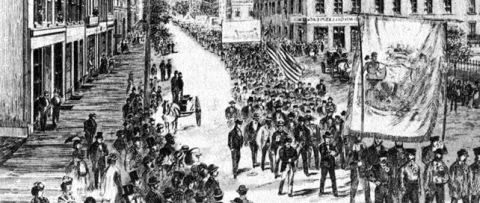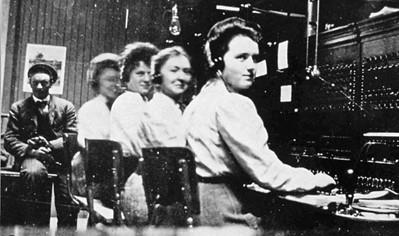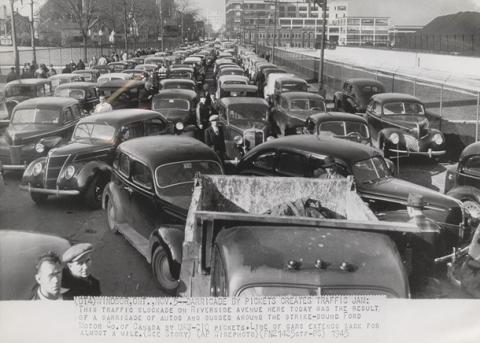By the end of this module, participants will be able to:
- Talk about some important labour actions in Canadian history,
- describe the positive impact labour has had on Canadian history and the rights we have today,
- identify ways that workers fought for and won those rights,
- talk about UTE’s history and some of its important successes.
1872 Toronto Printers’ strike

The Printers’ Strike was part of the Nine Hour Movement, a larger campaign that involved workers from various industries fighting for a shorter workday.
Strike leaders were arrested and charged with criminal conspiracy because
Union activity wasn’t yet legal. These actions only added to the cause and citizens continued to protest in support of the strikers. Prime Minister Sir John A. Macdonald saw the situation as an opportunity to gain political support and passed the Trade Union Act just three days after the protest at Queen’s Park began. With the passing of this Act, union activity became legal and protected in Canada.
1919: Winnipeg General Strike


The Winnipeg General Strike of 1919 was at the time the largest strike in Canadian history. More than 30,000 workers walked off their jobs causing factories, shops, transit and city services to shut down. The first to leave work, at 7:00 a.m., were the telephone operators at the city telephone exchanges – women who were not at this time union members.
The main goal of the strike was to improve working conditions in a post-WWI environment.
The federal government and employers opposed the strike and believed that strikers were communists, which was not the case. In order to crush the strike, they called in the RCMP. Strike leaders were arrested, protesters were injured and two were killed.
While it didn’t immediately achieve its aims, the strike did help unite the working class in Canada and some of its participants helped establish what is now the New Democratic Party.
Fun fact: Helen Armstrong, nicknamed “Ma,” was one of only two women among some 50 men on the Central Strike Committee. During the strike, she established the Labour Café, which provided women strikers with three free meals a day. This was an essential service for those who lost wages due to the strike. The cafe also welcomed men but encouraged them to pay or make a donation. It reportedly served 1,200 to 1,500 meals a day.

This was one of the largest and most important postwar strikes in Canada. 11,000 employees were strike for 99 days. 8,000 auto workers from other plants also participated in solidarity.
The strikers’ demands were:
- That the employer recognize their union (United Automobile Workers of Canada (UAW)
- mandatory union membership for all plant workers
- dues directly deducted from pay cheques and sent to union
The workers won what is now called the Rand Formula, after Supreme Court Justice Ivan C. Rand’s decision which stated that all workers covered by the collective agreement had to pay union dues — whether or not those workers were union members. This is now commonly known as “dues check-off” and why at UTE we refer to some members as “Rands.”
This was one of the largest and most important postwar strikes in Canada. 11,000 employees were strike for 99 days. 8,000 auto workers from other plants also participated in solidarity.
The strikers’ demands were:
- That the employer recognize their union (United Automobile Workers of Canada (UAW);
- mandatory union membership for all plant workers;
- dues directly deducted from pay cheques and sent to union.
The workers won what is now called the Rand Formula, after Supreme Court Justice Ivan C. Rand’s decision which stated that all workers covered by the collective agreement had to pay union dues — whether or not those workers are union members. This is now commonly known as “dues check-off” and why at UTE we refer to some members as “Rands.”
UTE History
The UTE can trace its direct roots back to 1943, when employees of the then-Taxation Department organized themselves into the Dominion Income Tax Staff Association.
However, federal public service unions were formed relatively recently, with the legislating in the mid-1960s of limited free collective bargaining. Until that time, federal workers were entirely dependent on the goodwill of the employer and the politicians for their well-being. There was no grievance system, no appeal process, no right to negotiate and no protection from discrimination, favouritism and harassment.
The UTE itself was founded as a component of PSAC in 1966. Around that time, three major pieces of legislation almost overnight moved the federal public service into the modern age of union-management relations. The Public Service Employment Act (PSEA) governed staffing matters. The Public Service Labour Relations Act (PSLRA) set down the rules and boundaries of collective bargaining. The Public Service Superannuation Act (PSSA) dealt with pension matters.
The CRA as public service agency (rather than department) was proclaimed on November 1, 1999. On December 12, 2003, the Canada Customs and Revenue Agency (CCRA) became the Canada Revenue Agency (CRA).
As an agency, the bargaining process changed in that UTE, through the PSAC, bargained directly with CRA. This changed again however in 2012 with the passing of Omnibus Bill C-45. All bargaining mandates must now be obtained from Treasury Board.
Some UTE Accomplishments
Staffing
Staffing was, and still is non-negotiable within the federal public service, however, through establishing a Staffing Committee, UTE has made some progress in protecting our members’ interests, such as:
- The elimination of quotas used in the Performance Review process.
- Rescinding many Developmental Assignment Programs where the UTE was able to prove they were inconsistent with the Public Service Employment Act and Regulations.
- The creation of joint union/management committees to deal with problematic issues surrounding Term Rehire, Casual Delegation Authority, PM Educational Requirements in Audit, Performance Management and Tax Centre Modernization.
- Effecting significant changes to the Agency’s assessment of “dependability” in the Term Rehire process.
Equal Opportunities
The UTE supports equal opportunity for all its members, regardless of sex, sexual orientation, age, mental or physical disability, race, colour, ethnic or national origin, religious or political belief, family or marital status, or conviction for which a pardon has been granted.
These principles led the UTE to establish an Equal Opportunities Committee with representatives from equity-seeking groups.
The Employment Equity Act specifies that employers must consult and collaborate with Unions in employment equity policies, procedures, and the implementation of programs and action plans. The UTE strongly believes that collaboration and co-operation is to take place at all levels. The UTE has Guidelines available for Local Joint Employment Equity / Diversity Committees.
Health and Safety
Your workplace shouldn’t make you sick, nor should it place your health and safety at risk. Yet, UTE members couldn’t always count on legislative protections from an unhealthy or unsafe work environment.
Workplace health and safety policies used to be determined by the employer alone. But in 1986, after a major three-year PSAC campaign, federal public service workers included under the Canada Labour Code’s health and safety provisions.
One of the Code’s requirements is that a National Health and Safety Committee be established. UTE is an active participate on this Committee along with employers and other unions.
Some of the achievements of the Policy Committee are:
- Revised Agency Health and Safety Policy;
- revised Emergency Procedures for bomb threats, fire, thefts, etc.;
- awareness Campaign on Scents in the Workplace;
- agreement to conduct Job Hazard Analysis for field workers;
- revised First Aid Policy;
- communication guidelines regarding situations where asbestos has been identified;
- an Agency policy against abuse, threats, stalking and assaults by persons outside the CRA;
- health and safety training for managers; and
- convinced the Agency of the importance of AEDs in all workplaces and a directive on the how they should be used.
Mental Health
Held our first National Mental Health Conference in October 2023.
A resolution passed at our 2021 Convention ensuring every conference would contain a mental health element.
